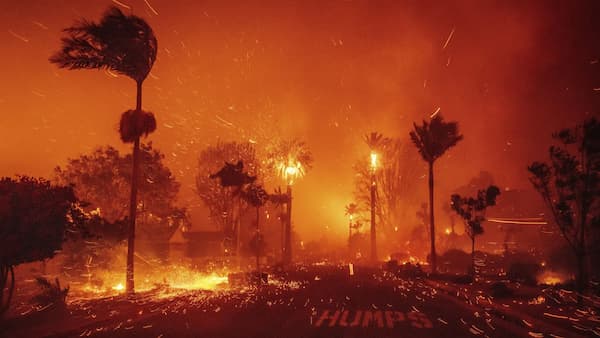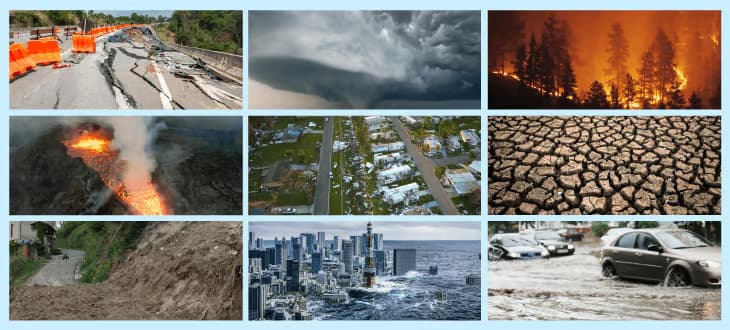As the Los Angeles wildfires rage on, their devastation reminded us of nature’s raw power and unpredictability. These fires, consuming vast landscapes and altering countless lives, echo the themes of chaos, resilience, and awe that have inspired classical composers throughout history. Classical music often serves as a lens to interpret and process such calamities, providing soundscapes that allow audiences to connect with the emotional intensity of natural disasters. Below, we explore some of the most compelling classical pieces inspired by the forces of nature, offering parallels to the relentless wildfires gripping California.

© Ethan Swope/AP photo
Beethoven’s Symphony No. 6 “Pastoral,” 4th Movement
Ludwig van Beethoven: Symphony No. 6 in F Major, Op. 68, “Pastoral” – IV. Thunderstorm: Allegro (Pittsburgh Symphony Orchestra; Manfred Honeck, cond.)
Orchestral music provides a vast canvas for composers to depict the grandeur and ferocity of natural disasters. One of the most famous examples is the fourth movement of Beethoven’s Symphony No. 6 Pastoral. This work paints a vivid picture of a countryside interrupted by a sudden and violent thunderstorm. The movement’s turbulent dynamics, rumbling timpani, and rapid string passages evoke the chaos of a storm, contrasting sharply with the peaceful scenes depicted in the preceding movements.
Joseph Haydn’s Symphony No. 8 Le Soir, 4th “La Tempesta”
Another compelling work is Joseph Haydn’s Symphony No. 8 Le Soir (The Evening), particularly its finale. The movement’s rapid tempo and dynamic contrasts vividly suggest the unpredictability of a stormy evening, showcasing Haydn’s skill in programmatic writing.
Richard Strauss’s An Alpine Symphony
Richard Strauss: An Alpine Symphony, Op. 64, TrV 233 (Weimar Staatskapelle; Antoni Wit, cond.)
Tone poems and programmatic symphonies have been especially effective in depicting natural disasters. Richard Strauss’s An Alpine Symphony is a monumental work that takes listeners on a journey through the mountains, culminating in a dramatic storm. The piece uses a massive orchestra to depict the overwhelming power of nature, with lightning, thunder, and torrential rain brought to life through Strauss’s orchestration.
Modest Mussorgsky’s Night on Bald Mountain
Rimsky-Korsakov’s “The Sea and Sinbad’s Ship” from Scheherazade
Modest Mussorgsky’s Night on Bald Mountain is another vivid tone poem. Though primarily focused on supernatural themes, its chaotic and tempestuous energy evokes the ferocity of a storm. Similarly, Rimsky-Korsakov’s The Sea and Sinbad’s Ship from Scheherazade captures the power and unpredictability of the ocean, with swirling melodies and dramatic crescendos representing waves and storms.

© greenmatch.co.uk
Heitor Villa-Lobos’s Amazonas
Heitor Villa-Lobos: Amazonas (Slovak Radio Symphony Orchestra; Roberto Duarte, cond.)
Antonio Estévez’s Cantata Criolla
Amazonas, a tone poem by Villa-Lobos, vividly portrays the power and mystery of the Amazon rainforest through exotic harmonies and dramatic orchestration. Estévez’s Cantata Criolla, a Venezuelan masterpiece, portrays a duel between a singer and the Devil, using vivid imagery to evoke the untamed forces of nature, reflecting Venezuela’s rugged landscapes.
Krzysztof Penderecki’s Threnody to the Victims of Hiroshima
Franz Schubert’s String Quartet No. 14 Death and the Maiden
While inspired by a man-made tragedy, Penderecki’s Threnody to the Victims of Hiroshima creates a dissonant and unrelenting soundscape that captures the aftermath of devastation, reflecting chaos and destruction in a way that parallels the impact of natural disasters. Schubert’s intense String Quartet No. 14 Death and the Maiden conveys turmoil and despair, its emotional content and dramatic shifts evoking the upheaval and devastation caused by natural forces.
Frédéric Chopin’s Prelude in D-flat Major, Op. 28 No. 15, “Raindrop”
Piano music, with its dynamic range and expressive capabilities, is another medium through which composers have depicted natural disasters. Frédéric Chopin’s Prelude in D-flat Major, Op. 28 No. 15, Raindrop, is a prime example. While the steady ostinato in the left hand suggests falling rain, the piece’s dramatic middle section conveys an escalating storm, symbolising the tension and release of nature’s power.
Franz Liszt’s La Lugubre Gondola
Franz Liszt’s La Lugubre Gondola is another piano piece with a somber connection to nature’s forces. Written in Venice, the piece reflects the ominous mood of the city’s canals, suggesting the constant threat of flooding. Its dark, brooding tone mirrors the inevitability of loss and destruction.
John Adams’s Short Ride in a Fast Machine
John Adam: Short Ride in a Fast Machine (Bournemouth Symphony Orchestra; Marin Alsop, cond.)
While not directly about a natural disaster, Adams’s Short Ride in a Fast Machine evokes a sense of unstoppable momentum, paralleling the relentless force of nature.
Classical music has a unique ability to translate the awe-inspiring and sometimes terrifying aspects of nature into sound. Whether through the depiction of storms, floods, or other calamities, these works invite listeners to experience the raw power and emotional depth of natural disasters. As we grapple with the wildfires in Los Angeles, these compositions remind us of our resilience and the profound impact of nature on our lives.
For more of the best in classical music, sign up for our E-Newsletter

